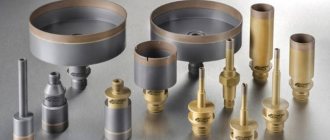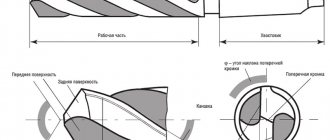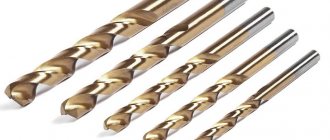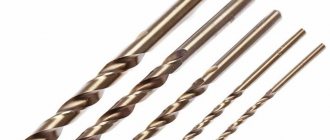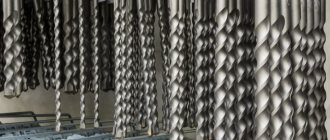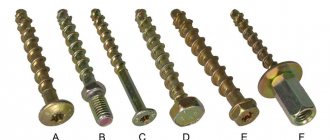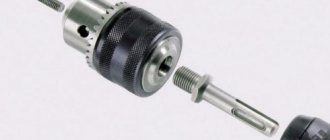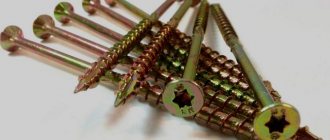When carrying out renovations in premises, it is necessary to make holes for fastening objects in concrete or brick walls. Diamond concrete drills are used for this type of process. Compared to metal drills, which quickly become dull, drilling with a diamond tool ensures a directed transfer of impact energy, maximizing the removal of slurry due to the spiral shape.
Description of annular diamond drills
A conventional drill - flat, screw, gun, produces a hole with the entire surface. Therefore, to form a hole with a large diameter, the diameter of the tool must be the same size. Considering the resistance of a durable material, this drilling method turns out to be very expensive.
- The working part of the annular drill looks different: it is a thin-walled crown, the edge of which is formed by diamond coating or segments.
- The crown body is connected to a shank of the appropriate shape - cylindrical, conical or special. For household devices, the product is produced with a universal shank or with appropriate adapters. However, when drilling a hole with a diameter of more than 80 mm, it is preferable that the shank has the appropriate shape and is attached without bushings.
- The crown body is made of steel grades 20, 30, 36, the extension - shank is made of steel 40, 45 is allowed.
Products with diameters from 20 to 215 mm are produced.
Specifications
The obvious advantage of a diamond drill is its high strength and durability. Diamond is the standard of hardness, and therefore all materials without exception can be processed with diamond spraying.
Unlike a conventional drill, a crown does not turn the core into chips, but cuts it out. The working surface is much smaller, which saves up to 85% of power.
The rotation speed is limited by the power of the tool and the thermal conductivity of the material being processed.
Based on the method of applying the working layer, there are 2 groups of crowns:
- C1 – a crown with a continuous diamond layer, used for making holes in concrete and reinforced concrete at a specific pressure of up to 5 MPa. The layer itself is a mixture of diamond-bearing technical powders of a certain grade. A mandatory requirement for it: diamonds must be opened.
- C2 – a crown with an intermittent diamond layer, allows a specific pressure of up to 2.5 MPa. Wider diamond-coated segments are fixed to the edge of the crown. The segments themselves can be of two types:
- round - installed on small-diameter drills, used for processing stone, tiles and glass;
- curved rectangular plate , like a solid one - such a tool is used when drilling large-diameter holes and for drilling.
The tool offers two drilling methods – wet and dry. The crowns have different structures.
- Drilling bit for dry drilling - that is, without water supply for cooling. They are made by laser welding, since during dry drilling the temperature reaches more than 40 C. Through holes are formed on the body of the bits, which remove heat and reduce the risk of damage to the tool.
- A drill for the wet method is made by welding; the supply of water during operation reduces the temperature, and, therefore, the load on the bit.
What does the market offer?
High-performance segments with a long service life are offered on the market by domestic and foreign manufacturers. A quality product comes at a high price. Foreign manufacturers include Metabo, Bosch, Makita, Stayer, FIT. Preference is given to Bosch tools, since due to the four-spiral shape, after finishing work it is easy to remove the remains of construction waste material from the recesses.
A cheaper option for the tool is Interskol products.
Russian production, as well as companies from the CIS countries and China, offer tools that are more affordable in price. Among them are “Interskol”, “Zubr”, “Enkor”. When choosing a tool, you need to understand that the drills are coated with a high-quality alloy and made using modern technologies, which means the price should be appropriate. There are often fakes in the markets that are darker due to the use of poor quality raw materials.
The concrete drill should have a white metallic color.
Scope of application
- Drilling rocks and rocks, as well as drilling in the ground when laying communications.
- Drilling of concrete and reinforced concrete structures. Despite the high cost, the tool is very cost-effective, as it significantly reduces the time required to complete the work. Drills are produced for both hand tools and construction equipment.
- Drilling tiles and stone – facing slabs are distinguished not only by their hardness, but also by their fragility. Making holes of even medium diameter in them for a socket is not at all easy. A diamond crown cuts out a fragment, tiles and stone do not experience such stress, damage is extremely rare.
- Glass is an even more fragile material, which during normal drilling cracks and crumbles into fragments with sharp edges. The diamond crown, thanks to a very thin cutting line, creates a narrow strip of impact, in fact, it simply cuts through, and the glass remains intact even when large-diameter holes are formed.
Pros and cons of using core drills
Compared to traditional screw drills, the ring-type tool has significant advantages and disadvantages
| Advantages | Flaws |
| possibility of using a lower power drive for drilling identical diameters | tool cost |
| high quality and low surface roughness inside the holes | difficulty in sharpening, impossibility of sharpening in cases where the cutting part is coated with diamond |
| installation on hand drills, drilling, milling and lathes | |
| simultaneous use in combination with other types of tools | |
| High speed drilling of large holes, increasing productivity | |
| optimal drilling mode at the same speed of movement of the cutting teeth, while at the edge of the twist drill the rotation speed is not the same | |
| low noise level during operation | |
| robust design ensuring safety |
The main disadvantage is the impossibility of obtaining deep blind holes. In addition, they note the higher cost of the tool and the lack of drills with a diameter of less than 12 mm.
Drilling process
Example of work: 3 holes for the lock tongue in a metal profile pipe.
Material processing when using annular drills can be carried out dry or wet. Dry drilling is used in domestic conditions, in the absence of the technical ability to supply cutting fluid and drilling holes with a diameter of up to 25 mm. This processing method is more labor-intensive, requires more time and entails faster wear of the cutting edge.
Drilling
A tool with a continuous layer is used when working with finishing: cutting out holes for communications - gas pipes, heating, and socket boxes. In this case, the aesthetics and precision of the hole are extremely important: the diamond cup allows you to form a perfectly round, clean hole in any ceramic tile or finishing stone.
The photo shows the process of drilling a plexiglass plate using a ring drill
Diamond annular drills with a diameter of 20 mm with an intermittent layer are suitable for processing natural stone, brick, concrete, marble, and tiles. When carrying out repair work, before drilling, you need to make sure that there are no hidden communications or frames in the area: a crown will cut through a reinforced concrete structure as easily as a nail in wood.
Drill 20 mm
Crowns with a diameter of 20 mm are available with both a solid and continuous diamond layer. There are two drilling methods:
- Dry - most often used in everyday life, since there is no need for holes of large diameter and depth. The dry method, due to the load on the tool, is more labor-intensive, takes longer, and generates a lot of dust. Therefore, the operator must wear a respirator.
- Wet method - when working, water is supplied under pressure into the inside of the tool and cools both the drill and the material. In addition, water washes away the resulting crumbs and dust.
Wet drilling is faster, more economical, and therefore much more widespread. The dry method is rather a necessary measure in cases where water supply is impossible.
Drills 50 mm
Crowns with a diameter of 50 mm are most often used for drilling technical and optical glasses. Here the accuracy and fineness of the cut is of great importance, but low material consumption is also important.
Recommended rotation speed for diameters from 25 to 50 mm is 1200–2500 rpm.
Cooling is a must. “Dry cutters”, that is, crowns for dry drilling, are highly undesirable.
GOST drills
Diamond core drills are regulated by GOST 24638-85. The standard regulates the geometric parameters of the product and permissible errors, as well as the material of manufacture for the crown body and holder.
GOST contains data on the composition of the diamond-bearing layer and the mass of diamonds. Depending on the type of crown - C1-2, C2-2, C1-3, diamond powders of different brands are used. In category C1-3, the use of grinding and synthetic powders is permissible.
According to GOST, the kit includes:
- diamond drill;
- 2 rings;
- instructions for replacing the ring.
Drills 125 and 160 mm
Diamond drills with a large diameter - more than 100 mm, are primarily used for core sampling. Today, the tool is used in almost all construction and repair work for drilling holes in partitions and ceilings, creating openings, connecting holes in pipelines, drilling difficult-to-cut materials - granite, diabase, and so on.
Drilling is carried out with cooling with water or compressed air.
How to choose?
To choose a drill for a power tool, you need to know exactly what type of electric drill is supported by a chuck - SDS-plus or SDS-max. The former are suitable for working with brick or medium-hard concrete. SDS-max shanks are adapted to interact with any hardness of concrete and brick. You can also choose a crown to create round holes. To guarantee quality, it is better to purchase drills from well-known companies.
In conclusion, it is worth noting that if the drill is broken or bent, you should absolutely not sharpen it yourself. Loading a rotary hammer with a crooked attachment can lead to tool breakage. Before each use of the drill, apply a special lubricant to the base of the head. This will increase the service life of the drill and hammer drill.
Advantage
- Diamond drills allow you to process materials of any hardness and strength with equal efficiency.
- High Precision – The diamond edge produces a very fine cut, allowing for extreme precision.
- Reduced energy costs - the crown cuts out the core rather than converting it into chips. As a result, working with a diamond drill will require less time and much less power.
- Drilling of concrete and reinforced concrete structures occurs using a non-impact method, which also reduces energy consumption.
- There is no dead center in , so there is no need for pre-drilling.
- When drilling, less dust is generated, and accordingly, the noise level is also significantly lower.
How to use the device?
Electrochemical coating of one metal with another, which is more resistant to mechanical movement and chemical processes, allows you to select the appropriate drill diameter and type for different processes. You also need to make sure that the nozzle does not overheat. The cooling device should be stopped at regular intervals. It is unacceptable to water the working parts with cold water. If, during drilling, an obstacle is discovered in the thickness of the concrete layer, you should change the drill used to cut metal. Having passed this section, insert the previous one again. For load-bearing walls it is better to use a hammer drill. The power of this device will guarantee the required quality of the desired holes.
